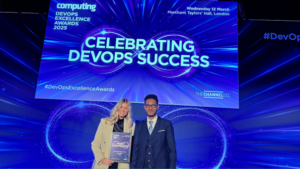Make DevOps work for you
What was observable on the Galapagos Islands in the 1830s is observable in public and private sectors in 2017. And unless you’ve been living on the Galapagos for the past few years, you’ll have seen DevOps touted as the solution to creating organisations that can respond to change.
A few months ago, analysts at Forrester pointed out that DevOps has gone from the realm of unicorns to mainstream. And so here we are: everyone is talking about DevOps.
But talk is cheap and misguided actions very expensive. So how do you turn the DevOps discussions into valuable DevOps activity?
Here’s Our Five-Step Guide:
1. Understand what DevOps is. It’s not something you buy off the shelf. It’s not a tool you install or a just another process you hire a consultant to develop. DevOps is much more of a philosophy of software development. It’s a culture that focuses on meeting business requirements quickly and efficiently, and overcoming any lingering differences between traditional development approaches and typical operator approaches. Think of it as an ongoing change project and you’ll get what you need from it much less painfully.
2. Ensure you’ve got the buy in from senior management and committed leaders at senior level. In this case the CIO, CTO or chief architect can take responsibility for keeping the focus on breaking down barriers between development and operations, and ensuring the approach remains centred on this core principle. They can also make sure that close collaboration between developers, system operators, and testers is maintained – and that those critical lines of communication between business users and service commissioners remain open.
3. Understand the demands of digital – and balance it with the rigour of ITIL. At present, only about five per cent of public services are driven by technologies that are digital by design. Applying DevOps to these technologies is relatively straightforward. On the other hand, mission-critical legacy platforms will need a more iterative approach, taking small steps to transformation, and applying DevOps one piece at a time. That requires not just digital skills but the depth of understanding residing in experienced IT managers.
4. Don’t forget security, compliance and governance. DevOps does not replace the need for quality assurance, software testing, or data validation – and Gartner has already suggested that DevOps be renamed DevSecOps because of the critical role of security. So, testing and security must be built into DevOps’ automated processes – and comply with GDS principals in the public sector. Those processes must also stay true to ITIL standards. Even at the accelerated DevOps pace, software should be put into production only when it has no vulnerabilities that can corrupt sensitive data.
5. Finally, work with the right people. Some service providers are great at automation, or at building digital services. Bringing them together is key. This means that IT practitioners who already have wide experience of delivering systems under the DevOps umbrella and are prepared to share best practice and ensure effective knowledge transfer are an essential part of your team. Look for service providers with real, in-depth experience of your sector, open technologies, and cloud-based solutions. Hands-on experience of designing, building, migrating, supporting and operating scalable and robust systems is also a key skill-set for making DevOps work.
Latest content
-

From ScanApp to Lego demos — What you need to know about Security & Policing 2025
Published on: 1 April, 2025 -

Truth, trust and transformation — 4 key takeaways from Zaizi’s AI in government event
Published on: 14 March, 2025 -

Zaizi talent shines at Computing DevOps Excellence Awards 2025
Published on: 13 March, 2025 -

Advancing DevOps practices with AI —lessons from AWS re:Invent
Published on: 10 March, 2025
